How to kill the NVIDIA GTX580 graphics card
With each new generation of video cards, the manufacturer, and in our case it will be a question of NVIDIA, is finalizing "protection against a fool." There are many cases when the service centers bring a video card burnt out of stupidity. Overheated due to poor cooling in the case or a badly screwed screw dropped to the card during operation, or the voltage on the GPU jumped.
Although many manufacturers support overclocking, NVIDIA is one of them, but these various protections create a lot of difficulties for overclockers.

With each new product, overclocking the video card for us, extreme overclockers, is becoming increasingly difficult. Protection against overheating, overvoltage, more and more, and to circumvent them more difficult. How to overcome all imaginable and unimaginable protection, I will try to tell you in this topic.
')

At once I will say that we did everything described below at our own peril and risk, and I do not advise you to repeat it.
Protection:
- temperature sensor . Rescues from overheating and prevents overclocking. For many extreme overclockers, soldering a pair of wires to certain legs of a resistor for voltage control is not difficult, but not everyone will venture to remove a transistor / resistor. After all, this way you immediately lose the manufacturer’s warranty.
What is so hated by this sensor? At too high temperatures, it will save your video card from inevitable overheating. But on the other hand, it will not allow overclockers to reach maximum frequencies. When the negative temperature is reached (for GTX580 this is -70-80 degrees Celsius), the sensor will think that something strange is happening and will turn off the video card. To bypass this protection, there is an excellent method - drop the transistor and a pair of resistors and close the necessary legs.
- Slow mode . If the core and memory frequencies are too high, the video card switches to the power saving mode, resetting the frequencies. Experimentally, we found that there is also a dependence on temperature. For example, at 1100 MHz for the core and -65 degrees, Slow mode is enabled, although at -60 everything works fine. But when setting up 1140 MHz for the core and a temperature of -60, the video card also drops out in Slow mode. Getting rid of this protection is also easy. Elimination of the same resistors and transistor + special BIOS version. This problem appeared not so long ago - with the release of the GTX480. The solution appeared almost immediately - the Greek overclocker hipro5 laid out the edited BIOS, in which the Slow mode was turned off. With the GTX580, the situation repeated. And the point here is not in the skills of the Greek overclocker, but in the fact that he did not spare the money to buy a utility to edit the NVID BIOS.
- vGPU Mod . Nvidia allows changing the voltage on the GPU, but the maximum threshold is too low for extreme overclockers. There are two solutions. The first, simplest, is to use the MSI Afterburner utility with the X prefix - this is a special version with increased frequency and voltage limits. The second method is complicated, but also more reliable. We will need a 100 Ohm resistor, it’s better to unscrew the resistance to maximum. On the iChill controller, which is responsible for the voltage on the core, we find the two legs we need and solder a resistor. Lowering the resistance, we increase the voltage. Up to 1.35-1.40V, the core responds to an increase in voltage, and the frequencies grow steadily.
- vMem Mod . Memory today is not so much affect the performance, but to conquer the records without a voltmod memory is not enough. With a standard voltage of 1.65 V, the memory is chased to 2400 MHz, after increasing the voltage to 1.8 V, the overclocking increases to 2550-2600 MHz. We will need a 50kΩ resistor that will control the voltage on the memory.
- vPll Mod . Allows you to raise the voltage on the data bus and increase the stability of the GPU at high frequencies. We didn’t do this modification, since when using a card with standard cooling (i.e. at positive temperatures) the probability of failure is very high.
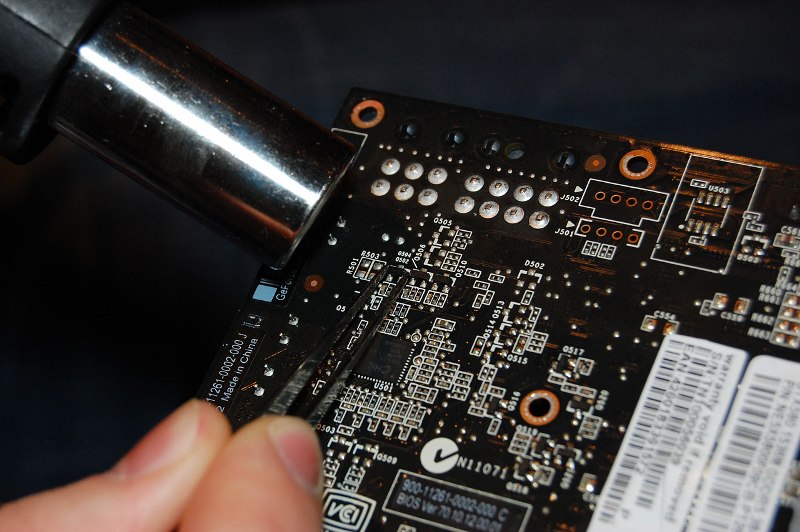
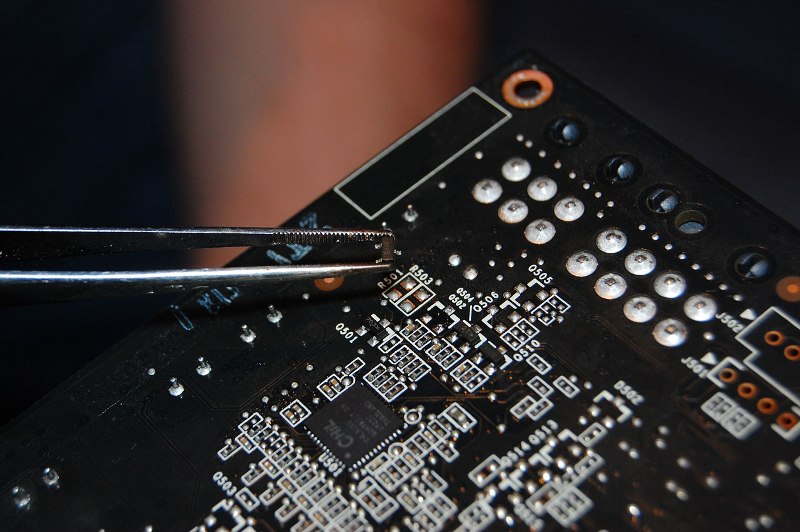
We close the legs, and the video card is able to work at -196 degrees Celsius:
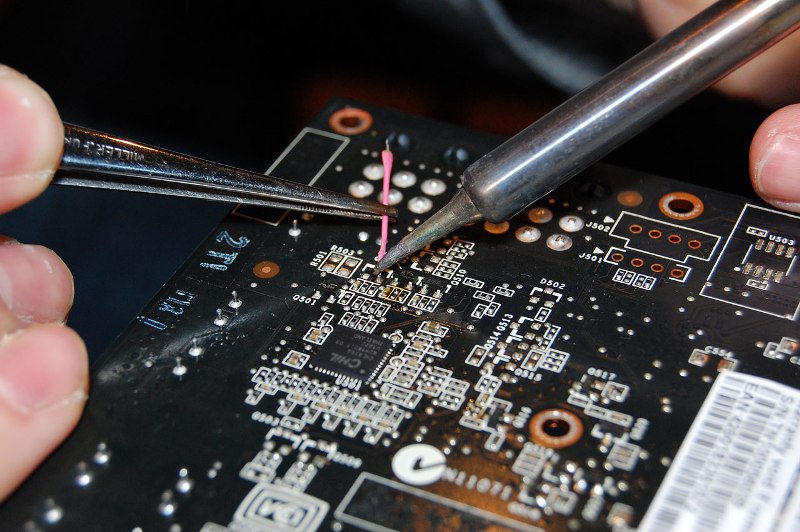
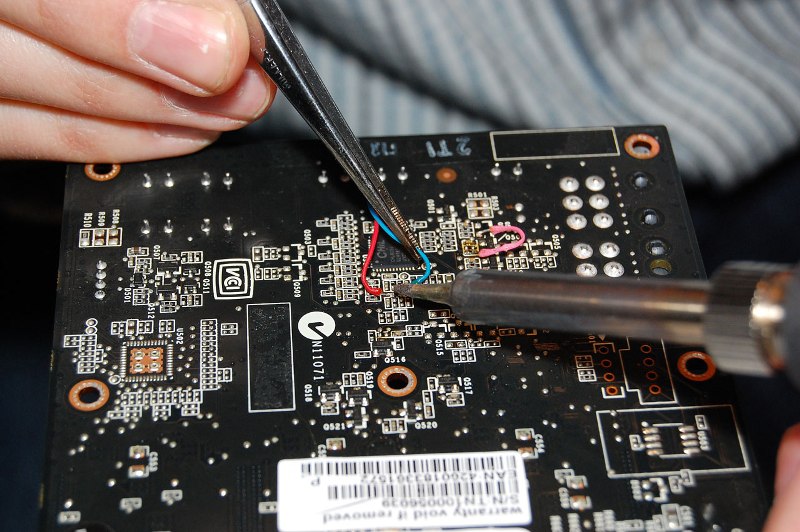
The iChill voltage controller used in the GTX580 is fairly new, and the datasheets for it are under NDA. Therefore, all the news about voltmodov video cards, we learn directly from the developers. This time, the “hero of our time” was a former employee of the company EVGA, and now an employee of ASUS, known in the world of overclocking under the nickname Shamino.
vGPU Mod is ready:
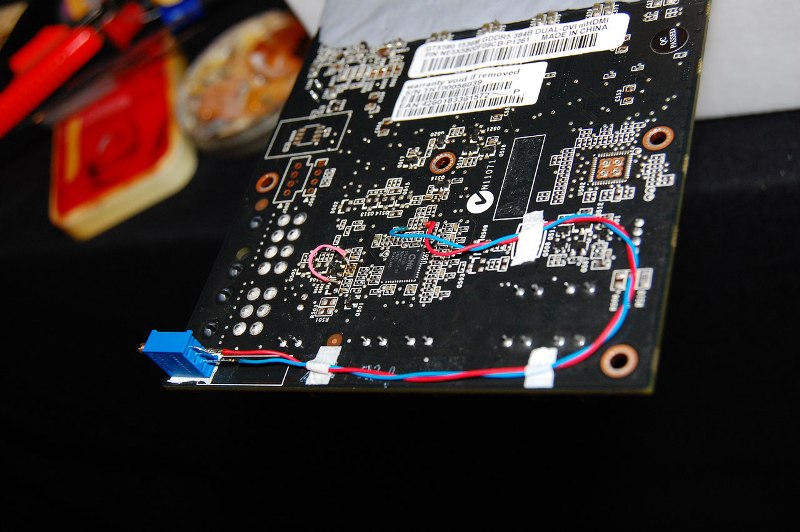
We do vMem Mod and it remains only to plant the voltage monitoring. To make monitoring the easiest and most convenient of the usual 4 pin molex. You can, of course, not to bother and every time to climb with a multimeter to check the desired voltage at certain measuring points on the back side of the board. But, in our opinion, it is much more convenient to make such monitoring and constantly monitor voltage drops.
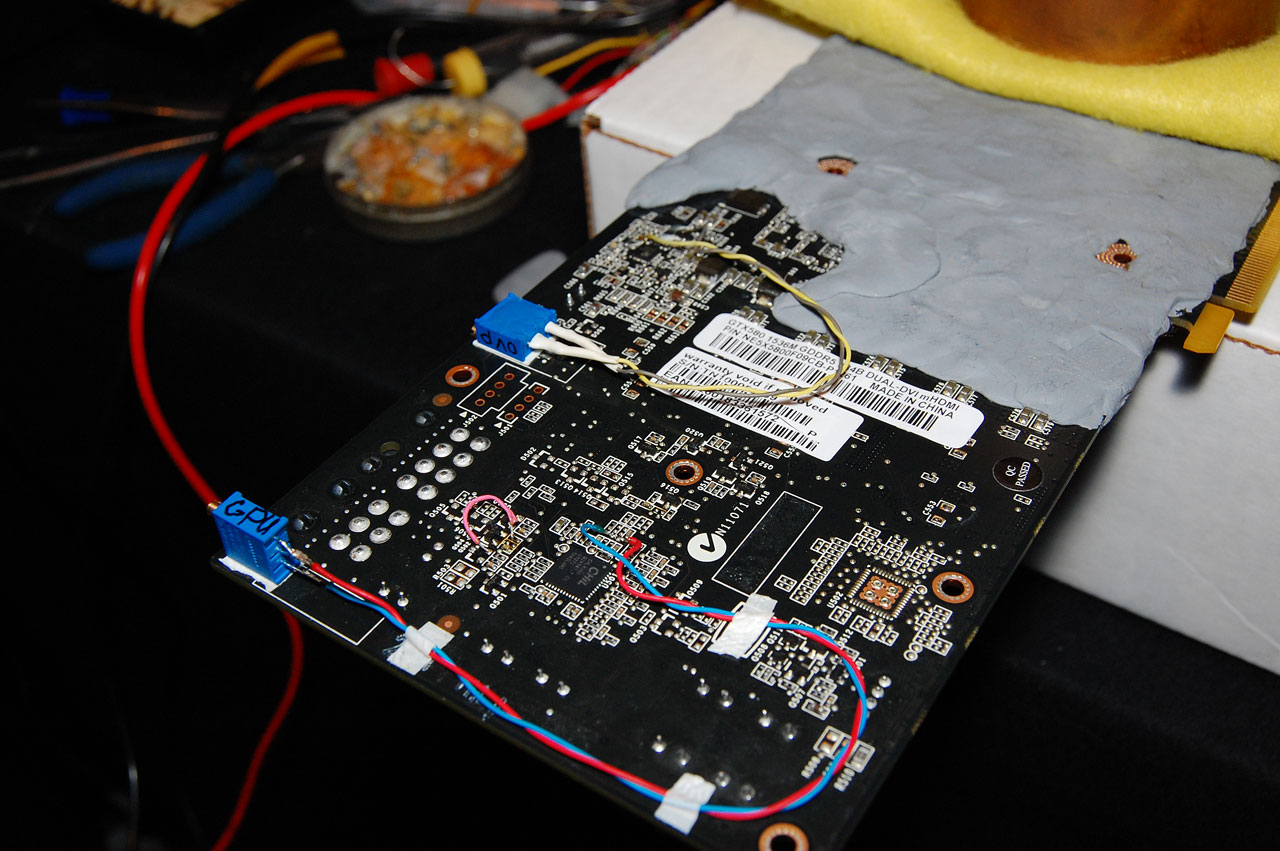
The final result:
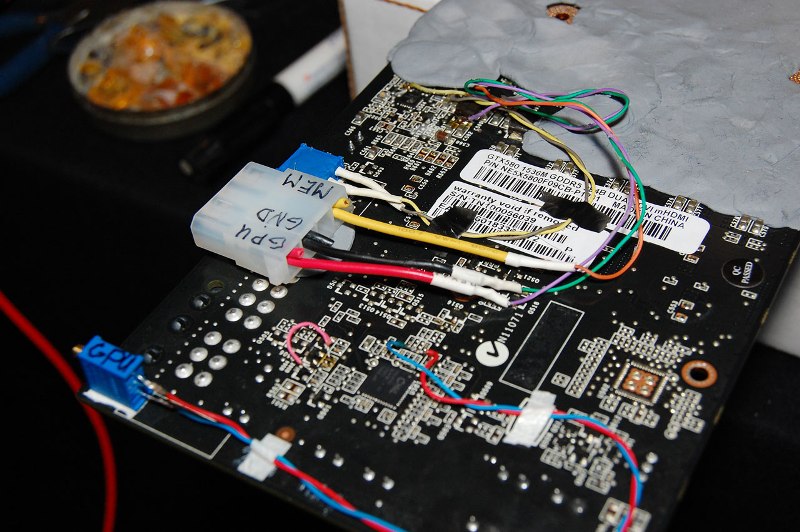
Test bench:
- Intel Core i7 990X @ 5892 MHz;
- EVGA X58 SLI Classified motherboard;
- RAM 2x 2 GB Corsair Dominator GTX2;
- NVIDIA GTX580 1230/2500 MHz graphics card;
- hard disk ADATA SSD 128 GB 596;
- Antec TPQ 1200 watt power supply;
- Windows 7 operating system 64 bits.
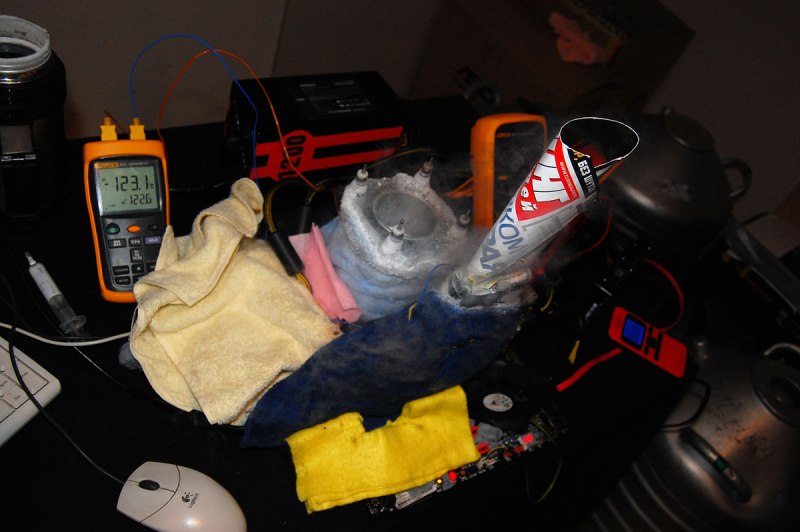
As a test utility this time, we abandoned the standard 3DMark packages and decided to test our strength in the popular DirectX 11 benchmark Heaven:
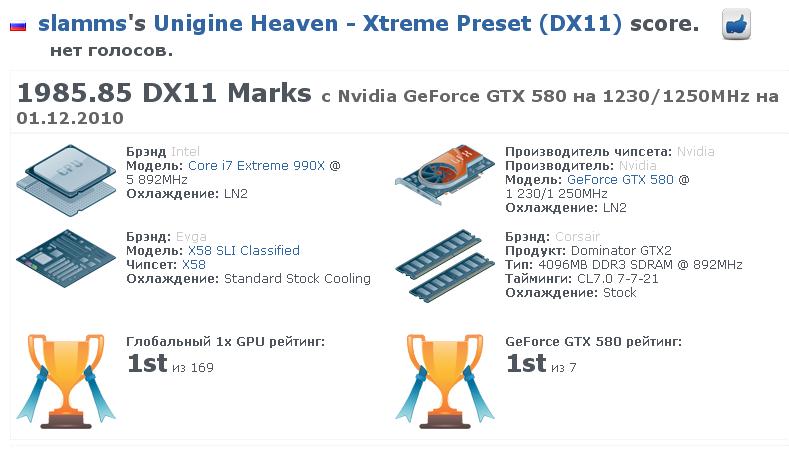
The result was the 1st place in the world on a single-chip video card.
Conclusion:
We were very pleased with the resulting effect, and the modifications made. First, everything we did added stability at high frequencies. Secondly, these modes allowed us to increase the overclocking potential by 130 MHz for the graphics processor and by 150 MHz for the video memory.
As the saying goes, “we will not stand for the price,” and as a result, in another category on Hwbot.org, the Russian tricolor is in the first place.
A more detailed review of the new items is available in the New Year issue of the computer magazine “i” .
We thank the company NVIDIA for providing the video card, as well as the man with "straight arms" - Alexey aka Lex_ for masterfully executed fashions.

Although many manufacturers support overclocking, NVIDIA is one of them, but these various protections create a lot of difficulties for overclockers.

With each new product, overclocking the video card for us, extreme overclockers, is becoming increasingly difficult. Protection against overheating, overvoltage, more and more, and to circumvent them more difficult. How to overcome all imaginable and unimaginable protection, I will try to tell you in this topic.
')

At once I will say that we did everything described below at our own peril and risk, and I do not advise you to repeat it.
Protection:
- temperature sensor . Rescues from overheating and prevents overclocking. For many extreme overclockers, soldering a pair of wires to certain legs of a resistor for voltage control is not difficult, but not everyone will venture to remove a transistor / resistor. After all, this way you immediately lose the manufacturer’s warranty.
What is so hated by this sensor? At too high temperatures, it will save your video card from inevitable overheating. But on the other hand, it will not allow overclockers to reach maximum frequencies. When the negative temperature is reached (for GTX580 this is -70-80 degrees Celsius), the sensor will think that something strange is happening and will turn off the video card. To bypass this protection, there is an excellent method - drop the transistor and a pair of resistors and close the necessary legs.
- Slow mode . If the core and memory frequencies are too high, the video card switches to the power saving mode, resetting the frequencies. Experimentally, we found that there is also a dependence on temperature. For example, at 1100 MHz for the core and -65 degrees, Slow mode is enabled, although at -60 everything works fine. But when setting up 1140 MHz for the core and a temperature of -60, the video card also drops out in Slow mode. Getting rid of this protection is also easy. Elimination of the same resistors and transistor + special BIOS version. This problem appeared not so long ago - with the release of the GTX480. The solution appeared almost immediately - the Greek overclocker hipro5 laid out the edited BIOS, in which the Slow mode was turned off. With the GTX580, the situation repeated. And the point here is not in the skills of the Greek overclocker, but in the fact that he did not spare the money to buy a utility to edit the NVID BIOS.
- vGPU Mod . Nvidia allows changing the voltage on the GPU, but the maximum threshold is too low for extreme overclockers. There are two solutions. The first, simplest, is to use the MSI Afterburner utility with the X prefix - this is a special version with increased frequency and voltage limits. The second method is complicated, but also more reliable. We will need a 100 Ohm resistor, it’s better to unscrew the resistance to maximum. On the iChill controller, which is responsible for the voltage on the core, we find the two legs we need and solder a resistor. Lowering the resistance, we increase the voltage. Up to 1.35-1.40V, the core responds to an increase in voltage, and the frequencies grow steadily.
- vMem Mod . Memory today is not so much affect the performance, but to conquer the records without a voltmod memory is not enough. With a standard voltage of 1.65 V, the memory is chased to 2400 MHz, after increasing the voltage to 1.8 V, the overclocking increases to 2550-2600 MHz. We will need a 50kΩ resistor that will control the voltage on the memory.
- vPll Mod . Allows you to raise the voltage on the data bus and increase the stability of the GPU at high frequencies. We didn’t do this modification, since when using a card with standard cooling (i.e. at positive temperatures) the probability of failure is very high.


We close the legs, and the video card is able to work at -196 degrees Celsius:


The iChill voltage controller used in the GTX580 is fairly new, and the datasheets for it are under NDA. Therefore, all the news about voltmodov video cards, we learn directly from the developers. This time, the “hero of our time” was a former employee of the company EVGA, and now an employee of ASUS, known in the world of overclocking under the nickname Shamino.
vGPU Mod is ready:

We do vMem Mod and it remains only to plant the voltage monitoring. To make monitoring the easiest and most convenient of the usual 4 pin molex. You can, of course, not to bother and every time to climb with a multimeter to check the desired voltage at certain measuring points on the back side of the board. But, in our opinion, it is much more convenient to make such monitoring and constantly monitor voltage drops.

The final result:

Test bench:
- Intel Core i7 990X @ 5892 MHz;
- EVGA X58 SLI Classified motherboard;
- RAM 2x 2 GB Corsair Dominator GTX2;
- NVIDIA GTX580 1230/2500 MHz graphics card;
- hard disk ADATA SSD 128 GB 596;
- Antec TPQ 1200 watt power supply;
- Windows 7 operating system 64 bits.

As a test utility this time, we abandoned the standard 3DMark packages and decided to test our strength in the popular DirectX 11 benchmark Heaven:

The result was the 1st place in the world on a single-chip video card.
Conclusion:
We were very pleased with the resulting effect, and the modifications made. First, everything we did added stability at high frequencies. Secondly, these modes allowed us to increase the overclocking potential by 130 MHz for the graphics processor and by 150 MHz for the video memory.
As the saying goes, “we will not stand for the price,” and as a result, in another category on Hwbot.org, the Russian tricolor is in the first place.
A more detailed review of the new items is available in the New Year issue of the computer magazine “i” .
We thank the company NVIDIA for providing the video card, as well as the man with "straight arms" - Alexey aka Lex_ for masterfully executed fashions.

Source: https://habr.com/ru/post/109774/
All Articles